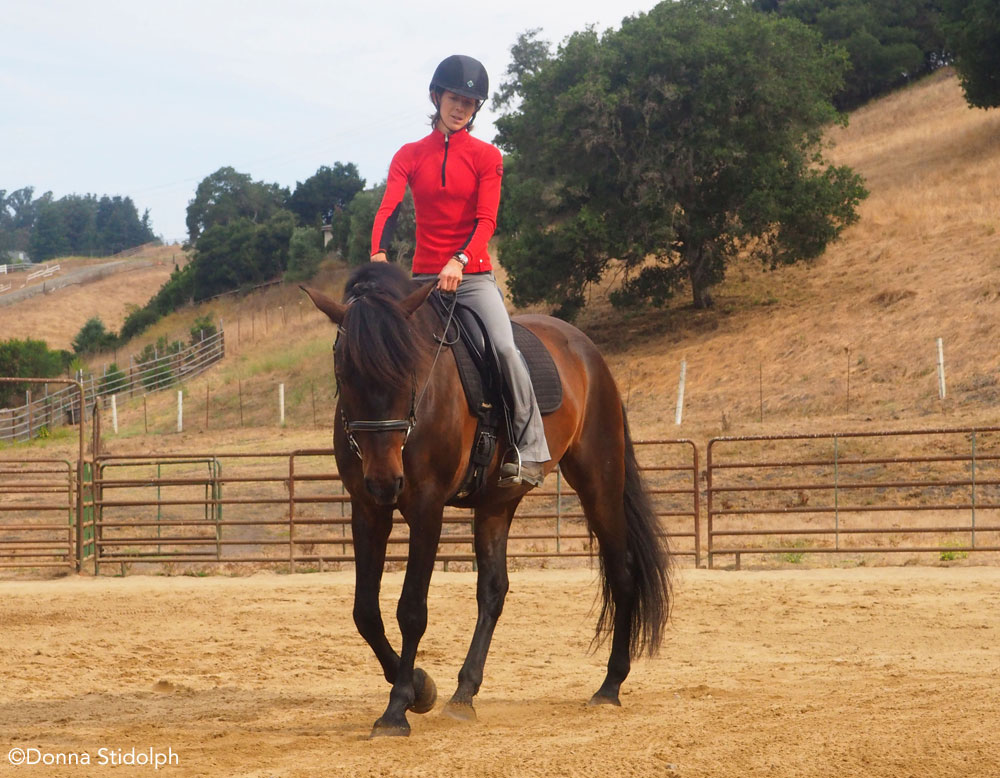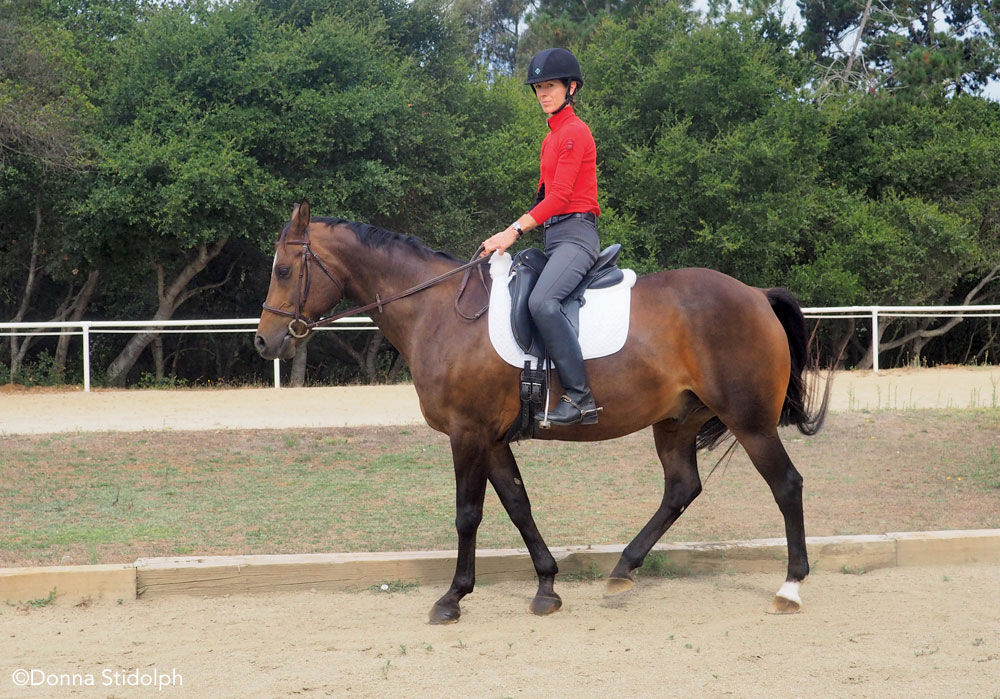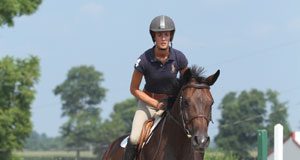Working at the walk, practiced and touted by old classical dressage masters, is always better than letting a horse stand around when for whatever reason he is not able to perform a regular training schedule. These equine exercises designed at the walk will help your horse maintain fitness during the warm up and cool down process.
Further, the fine-tuned motor control that is possible at the walk enables you to help your horse find more range of motion and joint flexion that will become habitual.

During periods of reduced exercise due to either weather or injury, you can accomplish a great deal in 25 minutes with one of the walk routines featured here. Even for riders with busy lives, there is no reason to not make use of these. Walking exercises during the warm up process of your ride can become extremely beneficial for your horse.
Concentrate on creating the highest quality movements and figures for these 25 minutes. Treat them with the same focus as you would a dressage test or show. You can easily extend their benefits by doing three minutes of dynamic stretches or calisthenics prior to mounting.
Within each routine featured here, spend about two minutes on each exercise and continue to cycle through them until your time is up.
How to Handle Downtime
Interruptions to a horse’s normal training routine or exercising fewer than three days per week will lead to a measurable loss of fitness after four weeks. This “detraining” effect continues up to 12 weeks, at which point a rider should consider the horse entirely out of condition.
A horse’s metabolic system and connective tissue are stressed by large vacillations in fitness, especially as he ages; every effort should be made to avoid long layoffs lasting more than four weeks at a time. Obviously, every rider will experience schedule restraints that lead to periods of lesser activity, during which the walking routines I’ve just described, at the minimum, can be used.
During periods of less activity, riders often may fret unnecessarily about the horse losing cardiovascular fitness. Instead, they should concern themselves with postural tone and fitness of muscular patterns. Horses make cardiovascular adaptations quickly and efficiently. It’s fine for them to lose fitness in their respiratory system, sweating responses, and blood volume for an extended period. Once a horse is placed back in full-time work, his cardiovascular system makes fitness gains in as swiftly as two weeks. His supporting tissues, muscles, and bones, however, will require up to four months or more.

Do not be tempted to make up for a diminished training schedule by getting your horse out once or twice a week and making him work up a good sweat with the hope that you are thwarting fitness loss. I sometimes see riders with good intentions but tight schedules show up at the barn once or twice a week, only to hook their horse onto the longeline and run him around until he is panting and sweaty. Obviously, they believe they are combating a deterioration of fitness.
In reality, they are doing more harm than good. While they are in fact taxing the horse’s respiratory system, they are allowing his postural muscles to slacken while simultaneously creating poor habits in his gymnastic muscles that build tension during these short bursts of activity without precise alignment, warming up, or signals from his proprioceptors.
Exercises: Walk Routine 1
With each of these routines, spend about two minutes on each exercise and repeat for 25 minutes.
It’s far better to forego the once-weekly, sweaty workout in place of multiple shorter sessions using exercises to recruit postural muscle effort. In sum, allow cardiovascular fitness to go by the wayside because it comes back quickly. Do not allow postural practice and muscle training to go by the wayside because you will create problems down the road.
Here is the first set of horse exercises at the walk. It includes accordion topline, spiral in and out, snowman, and simple ground poles.
Accordion Topline:
Riding around the edge of your arena in a brisk, forward walk, practice lengthening and shortening your reins and asking your horse to change frames, from longer to shorter.
Spiral In and Out:
From a 20-meter circle, spiral in to an 8-meter circle. Then, maintaining inside bend, leg-yield back out to your original 20-meter circle, being careful not to lose energy.
Snowman:
Ride once around a 20-meter circle to the left, then, at the top, change bend and ride a 10-meter circle to the right. Resume your 20-meter circle. Your figure should look like a snowman with a fat body and a smaller head on top.
Simple Ground Poles:
Set up as many poles as you have available in a random fashion all around your arena. Proceed in a brisk walk over the poles, riding turns and loops creatively.
Exercises: Walk Routine 2
Here is the second set of horse exercises at the walk. It includes long-and-low transitions, polish your turns, and proprioception box.
Long-and-low Transitions:
With the horse in a long-and-low frame, ride transitions from working walk to extended walk; repeat. Aim to keep his head and neck reaching down low toward the ground into a light rein contact during these transitions. He will need to recruit core musculature for balance.
Polish Your Turns:
Interspersed with intervals of active, ground-covering walking, practice several turns-on-the-forehand and turns-on-the-haunches in each direction. Be sure to ride several vigorous walk steps between each turn.
Proprioception Box:
Arrange a box using four ground poles with the corners of the box lifted on risers. Ride a variety of patterns over and through the box—cloverleaf, circle around each corner of the box, figure eight.
Exercises: Walk Routine 3
Here is the third set of horse exercises at the walk. It includes speed changes, cornerstone transitions, and wavy lines.
Speed Changes:
Ride various figures in the arena while changing the speed of your walk. Aim for four distinct speeds (super slow, slow, medium and fast), and spend 20 strides at each speed. Repeat.
Cornerstone Transitions:
Ride transitions to the halt every 10 strides. At every other halt transition, ask the horse to back up 6 to 10 steps, then carry on.
Wavy lines:
Ride a “scalloped” edge around the track of your arena. Maintain a brisk, lively walk tempo and ride a wavy serpentine with approximately 3-meter loops back and forth from left to right.
This excerpt from 55 Corrective Exercises for Horses by Jec Aristotle Ballou is adapted from and reprinted with permission from Trafalgar Square Books (www.horseandriderbooks.com).





